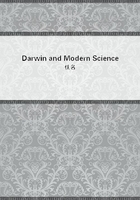
第298章
A complex mechanical system may be capable of motion in several distinct modes or types, and the motions corresponding to each such type may be arranged as before in families. For the sake of simplicity I will suppose that only two types are possible, so that there will only be two families;and the rotational momentum is to be constant. The two types of motion will have certain features in common which we denote in a sort of shorthand by the letter A. Similarly the two types may be described as A + a and A +b, so that a and b denote the specific differences which discriminate the families from one another. Now following in imagination the family of the type A + a, let us begin with the case where the specific difference a is well marked. As we cast our eyes along the series forming the family, we find the difference a becoming less conspicuous. It gradually dwindles until it disappears; beyond this point it either becomes reversed, or else the type has ceased to be a possible one. In our shorthand we have started with A + a, and have watched the characteristic a dwindling to zero. When it vanishes we have reached a type which may be specified as A; beyond this point the type would be A - a or would be impossible.
Following the A + b type in the same way, b is at first well marked, it dwindles to zero, and finally may become negative. Hence in shorthand this second family may be described as A + b,...A,...A - b.
In each family there is one single member which is indistinguishable from a member of the other family; it is called by Poincare a form of bifurcation.
It is this conception of a form of bifurcation which forms the important consideration in problems dealing with the forms of liquid or gaseous bodies in rotation.
But to return to the general question,--thus far the stability of these families has not been considered, and it is the stability which renders this way of looking at the matter so valuable. It may be proved that if before the point of bifurcation the type A + a was stable, then A + b must have been unstable. Further as a and b each diminish A + a becomes less pronouncedly stable, and A + b less unstable. On reaching the point of bifurcation A + a has just ceased to be stable, or what amounts to the same thing is just becoming unstable, and the converse is true of the A + b family. After passing the point of bifurcation A + a has become definitely unstable and A + b has become stable. Hence the point of bifurcation is also a point of "exchange of stabilities between the two types." (In order not to complicate unnecessarily this explanation of a general principle Ihave not stated fully all the cases that may occur. Thus: firstly, after bifurcation A + a may be an impossible type and A + a will then stop at this point; or secondly, A + b may have been an impossible type before bifurcation, and will only begin to be a real one after it; or thirdly, both A + a and A + b may be impossible after the point of bifurcation, in which case they coalesce and disappear. This last case shows that types arise and disappear in pairs, and that on appearance or before disappearance one must be stable and the other unstable.)In nature it is of course only the stable types of motion which can persist for more than a short time. Thus the task of the physical evolutionist is to determine the forms of bifurcation, at which he must, as it were, change carriages in the evolutionary journey so as always to follow the stable route. He must besides be able to indicate some natural process which shall correspond in effect to the ideal arrangement of the several types of motion in families with gradually changing specific differences. Although, as we shall see hereafter, it may frequently or even generally be impossible to specify with exactness the forms of bifurcation in the process of evolution, yet the conception is one of fundamental importance.
The ideas involved in this sketch are no doubt somewhat recondite, but Ihope to render them clearer to the non-mathematical reader by homologous considerations in other fields of thought (I considered this subject in my Presidential address to the British Association in 1905, "Report of the 75th Meeting of the British Assoc." (S. Africa, 1905), London, 1906, page 3. Some reviewers treated my speculations as fanciful, but as I believe that this was due generally to misapprehension, and as I hold that homologous considerations as to stability and instability are really applicable to evolution of all sorts, I have thought it well to return to the subject in the present paper.), and I shall pass on thence to illustrations which will teach us something of the evolution of stellar systems.